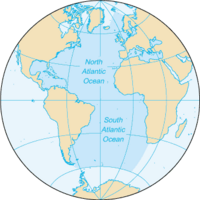
Photo from wikipedia
Abstract The middle Eocene was a key period of global climate change from a warm “greenhouse” to a cooling “doubthouse”. At the middle Eocene, an extensive arid climate in China… Click to show full abstract
Abstract The middle Eocene was a key period of global climate change from a warm “greenhouse” to a cooling “doubthouse”. At the middle Eocene, an extensive arid climate in China was recorded in the mudstones and shales interbedded with salinastone which formed good hydrocarbon source rocks, especially in the Bohai Bay Basin. The sedimentary paleoenvironment and its variations affected the source rock quality and distribution. Based on successive and dense sampling of the middle Eocene Shahejie Formation shale (MES shale) in Nanpu Sag of Bohai Bay Basin, petro-mineralogical tests, geochemical methods and spectrum analysis were performed to analyse the palaeoenvironmental fluctuations and the responses to Milankovitch cycles. Element analysis on MES shale shows that the middle Eocene climate was arid and the sediments were deposited under dysoxic/suboxic conditions with relatively high salinity. Based on the Δlog R method, the organic matter (OM) abundance was evaluated and ranged from 0.18 to 3.55 wt % for MES shale. The mean primary productivity of 545 g C m−2 yr−1 shows a eutrophic environment in middle Eocene Nanpu paleolake. Wavelet analysis performed on gamma logging and palaeoenvironmental proxies revealed clear Milankovitch cycles for MES shale, and the cyclostratigraphic and palaeoenvironmental fluctuations were effected by astronomical oscillation periods of the short eccentricity cycle (100 k.y.), obliquity cycle (39 k.y.) and precession cycle (19 k.y.). The depositional rate of MES shale was corrected to 0.43 m/k.y. The sedimental process of MES shale was associated with palaeoenvironmental variation, which have been divided into four stages affecting OM accumulation. A hypothesis that the vast carbon of “greenhouse” gases in the Palaeocene and early Eocene was fixed in organic matters during middle Eocene and enriched in the hydrocarbon source rocks of the sedimentary basins formed at early Eocene was proposed to explain the “doubthouse” world in the Eocene.
Journal Title: Marine and Petroleum Geology
Year Published: 2020
Link to full text (if available)
Share on Social Media: Sign Up to like & get
recommendations!